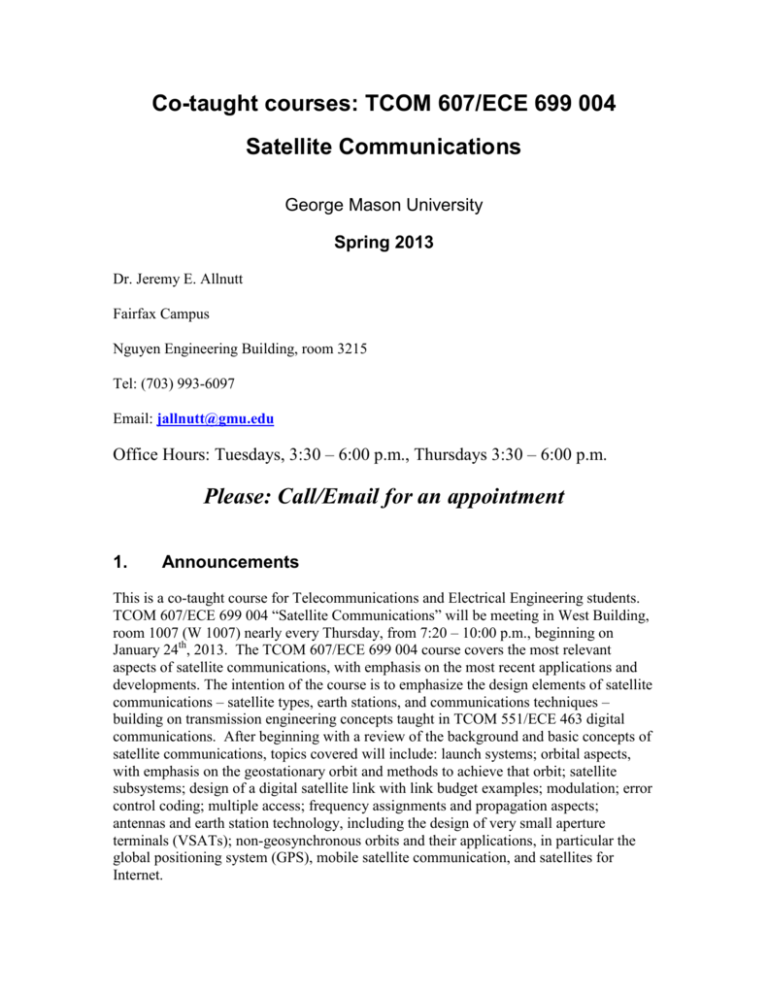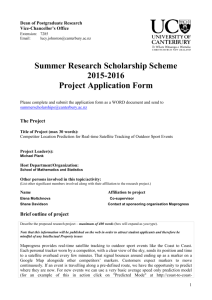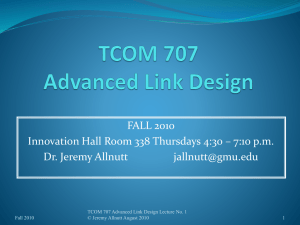Digital Communications - TCOM 551 and ECE 463
advertisement

Co-taught courses: TCOM 607/ECE 699 004 Satellite Communications George Mason University Spring 2013 Dr. Jeremy E. Allnutt Fairfax Campus Nguyen Engineering Building, room 3215 Tel: (703) 993-6097 Email: jallnutt@gmu.edu Office Hours: Tuesdays, 3:30 – 6:00 p.m., Thursdays 3:30 – 6:00 p.m. Please: Call/Email for an appointment 1. Announcements This is a co-taught course for Telecommunications and Electrical Engineering students. TCOM 607/ECE 699 004 “Satellite Communications” will be meeting in West Building, room 1007 (W 1007) nearly every Thursday, from 7:20 – 10:00 p.m., beginning on January 24th, 2013. The TCOM 607/ECE 699 004 course covers the most relevant aspects of satellite communications, with emphasis on the most recent applications and developments. The intention of the course is to emphasize the design elements of satellite communications – satellite types, earth stations, and communications techniques – building on transmission engineering concepts taught in TCOM 551/ECE 463 digital communications. After beginning with a review of the background and basic concepts of satellite communications, topics covered will include: launch systems; orbital aspects, with emphasis on the geostationary orbit and methods to achieve that orbit; satellite subsystems; design of a digital satellite link with link budget examples; modulation; error control coding; multiple access; frequency assignments and propagation aspects; antennas and earth station technology, including the design of very small aperture terminals (VSATs); non-geosynchronous orbits and their applications, in particular the global positioning system (GPS), mobile satellite communication, and satellites for Internet. Two in-class tests will be given in week 6 of the semester (February 28th, 2013) and week 13 of the semester (April 18th, 2013). The final exam on May 9th, 2013, will consist of student presentations of their research papers. If the class has substantially more than 10 students registered, the last two class days (May 2nd and May 9th) will be given over to the student presentations. The research papers will be graded for class credit. NOTE: The top three term presentations will be eligible to be entered into the SSPI competition that will be run in spring 2014. A cash award will be given by SSPI to the winning presentation(s). The SSPI presentations are normally held in April. 2. Expected Background Advanced college-level mathematics is not generally required, but aspects of analytical geometry introduced in ECE 463/TCOM 551 will be developed further in TCOM 607/ECE 699 004. The ability to manipulate algebraic equations, as well as being fully confident with working in the decibel notation, will be required in this course. As with all more advanced TCOM courses, concepts and techniques learned in earlier classes will be reinforced with many numerical examples. 3. Expected Learning Experience TCOM 607/ECE 699 004 will build on the concepts introduced in TCOM 551/ECE 463 (antennas, link budgets, propagation effects, multiple access, etc.) and then expand them to cover all facets of satellite communications. TCOM 607/ECE 699 004 will provide students with a sound understanding of both the design of satellites and the choice of orbits to use for a variety of missions, in addition to conferring the ability to design a variety of digital services that would utilize satellites as a main node, or one of the nodes, in a communications network. Students will greatly benefit from the real-world applications taught in the course. The mandatory and supplementary text book for this course provide the bulk of the information, but substantial material for the course will be provided in PowerPoint slides. Students who have registered for the class can download the slides from Backboard. The lectures are posted to Blackboard about a week before class, and the corresponding assignments are also uploaded to Blackboard. All assignments have to be handed in as hard copy on the designated date. The homework solution sets will be available before the test in which the homework forms a significant input. They will be sent out as Email attachments. NOTE: All solution sets will be distributed to the class through George Mason University’s Email system. It is therefore essential that students activate their GMU Email accounts to obtain this information. It is a simple matter to have your Email forwarded to a preferred address from the GMU address. However, please remember you will need to clean out your GMU account regularly so as not to have a storage problem and consequently rejected Emails. Also, please do not use hotmail as a forwarding account, since you will probably not be able to receive some of the Emails due to the size of the file (1 to 4 Mbytes). 4. Required Books and Calculator A. Mandatory Textbook Course Text: Pratt, Bostian, and Allnutt, Satellite Communication Systems, 2nd Edition, John Wiley & Sons, 2003, ISBN 0-471-37007-X NOTE: While the course will tend to follow the textbook fairly closely, additional material will be provided in class on current topics. Students are also encouraged to seek out additional references (see some possible sources below). B. Recommended Supplementary Textbook J.E. Allnutt, Satellite-to-Ground Radiowave Propagation, 2nd Edition, IET UK, 2011, ISBN 978-1-84919-150-0 Acknowledgments: Much of the material used in this course is based on notes assembled over a number of years by a variety of professors who have taught Satellite Communications, particularly Dr. Tim Pratt, Dr. James LaPean, Dr. Leila Ribeiro, Dr. Seema Sud, as well as the present instructor (Dr. Jeremy Allnutt). All material is used with permission of the author and is not to be reproduced without permission from the author. C. Calculator Students should have a calculator, or a PDA (or equivalent) with a calculator option. The calculator shall have the following functions, as a minimum: (a) (b) (c) (d) LOG (This key will convert an entered number into its log10 value) 10x (This key will convert the log10 value back into the original number) SIN (This key will convert an angle into the sine of that angle) COS (This key will convert an angle into the cosine of that angle) (e) TAN (This key will convert an angle into the tangent of that angle) (f) SIN-1 (This key will convert the sine value of an angle back into the angle; this action is sometimes called ARCSIN rather than SIN-1) (g) COS-1 (This key will convert the cosine value of an angle back into the angle; this action is sometimes called ARCCOS rather than COS-1) (h) TAN-1 (This key will convert the tangent value of an angle back into the angle; this action is sometimes called ARCTAN rather than TAN-1) The calculator should also have the normal +, -, , arithmetical actions. A number of examples in class will require the conversion from normal numerical values into logarithms (i.e. log10), and vice versa, in addition to using the standard geometrical functions sine, cosine, and tangent. NOTE: Calculators will be required in the tests and exams. For this reason, advanced calculators that store equations and other processes will not be permitted. Please make sure you have only a relatively simple calculator for the closed book, closed notes tests and final exam. Unusual equations, or long equations, will be given to students in exams in the form of a handout sheet. The key to the exams is being able to understand the processes rather than memorization. A sheet with equations will be available in each test or exam. 5. Lecture Notes As noted earlier, Power Point slides for the lectures will be posted on Blackboard. The slides for the first lecture will be uploaded at least a week before the semester starts, along with the corresponding assignment. Subsequent lectures and assignments will be available in a timely fashion before class time. 6. Homework 1. Six homework exercises will be assigned periodically. The first three homeworks will be prior to the first test and the next three homeworks will be prior to the second test. Homeworks are normally due the week after being assigned. 2. Homework scripts will be provided by the students in hard copy to the instructor at the mid-class break of the appropriate lecture. All homework will be graded for credit. In most questions, what will carry the greatest number of marks will be the process in which the question has been answered, not the answer itself. Please give all intermediate steps in a question so that partial credit may be given, even though you may not have reached the correct solution. And PLEASE put your name and ID number on each sheet of paper and staple the sheets together. 3. Homework will not normally be accepted by Email unless prior permission has been given, e.g. a student is on travel. 4. Late homework will only be accepted a. With prior permission, and b. If the solution set for that homework has not yet been distributed to the class. 5. Solution sets for the homeworks will be available before the tests that have been based on topics covered in those homeworks. Students are encouraged to work together on homework problems, but they should only submit their own written work. 6. Research Paper A research paper will be required for this class. The research paper will take the place of the final exam and it will constitute 15% of your overall grade. The paper will be presented on the scheduled exam day (May 9th, 2013). If the registrations in the class exceed 14, then the last two class days will be used for the presentations, which should run for about 20 minutes each. All students are required to attend the presentations of the other students. The grade will be assessed on both the content of your presentation and the effectiveness of your presentation. You will not be required to submit a written report, but a soft and hard copy of your Power Point presentation shall be handed in at the time of, or before, your presentation. Students may choose a topic in the broad area of satellite communications (fixed services, mobile services, direct broadcast services, deep space communications, tactical communications via UAVs, High Altitude Platforms, etc.). The papers can concentrate on technological aspects of the on-board equipment, the propagation characteristics limiting communications, etc., and the papers can look at single spacecraft attributes, whether deep-space or earth satellites, or cluster operations. In a like manner, papers can concentrate on the earth station technological attributes, whether for large, medium, or small earth stations, or mobile handsets. Example s could be as shown below (by no means an exhaustive set): (a) Phased array antennas for mobile earth stations. (b) The future of Satellite Direct-to-Home TV services. (c) The future of mobile satellite communications. (d) The use of Q/V-band for satellite communications. (e) The future of satellite direct-to-home broadband internet services. (f) Launcher technologies evolution. (g) Tracking, telemetry and control evolution. (h) Environmental impact of satellite communications. (i) Satellite vs. terrestrial based communications. (j) Routing protocols for satellite communications. (k) Satellite radio. (l) Internet delivery to commercial airlines (m) Optical communications (n) Cluster-Systems (o) Multiple use satellites (i.e. hosted payload satellites) (e.g. Intelsat 22) (p) Submarine communications from satellites You are highly encouraged to choose a topic that interests you the most. If you are interested in working on a topic that greatly differs from the ones listed above and/or is well outside traditional satellite communications, you are required to submit, either in hard copy form or electronically, no later than February 7th, a ½ to 1 page proposal describing your proposed work. The proposal should clearly discuss the topic, proposed method of research, and expected outcome/results of the effort. If you choose one of the topics above, or something similar, submission of a proposal is not required. IMPORTANT NOTE Students are encouraged to find, and use, any and every source they may locate to answer a question or for their term paper. HOWEVER: if elements of their paper have been downloaded from the web or transcribed from another source, STUDENTS MUST WITHOUT FAIL acknowledge the source document. If the elements used are exact copies, those passages must be within quotation marks to note they are not original statements of the student. This includes written sections, diagrams, and pictures. Failure to acknowledge a source used is considered to contravene the copyright act and may also be subject to honor code proceedings if the student claims the work to be original when it is copied from another person or source. Deliverables The research papers shall be presented in class as a Power Point presentation, or equivalent. No written report is required, but the presentation material shall be submitted in both soft and hard copy. All presentations shall be organized as follows. Title slide: the title slide must include project title, course, instructor name, student name, and date. The presentation shall follow a logical progression, e.g.: introduction, background information, motivation, description of objectives, information discovered, any analysis conducted, results and conclusions. It shall be a stand-alone presentation. References. A list of references used to develop the presentation shall be given. All texts, papers, manuals, reports, or other sources used in the project must be properly acknowledged. Use the same format for references as found in IEEE journal proceedings. Appendices (optional). These need not be presented but should list information there is no time to present. Note that the information presented must stand on its own. Appendices can be used to provide additional detail, e.g. source code or formula derivations, or substantiation, e.g. of numerical results that are summarized in the body of the presentation. Grading Grading will be based both on the content of the material presented and on the presentation itself, and it will count as 15% of the overall class grade. The best three presentations will be eligible to be submitted by the student to the SSPI competition which is run in spring semesters. The winner(s) of the SSPI competition receive cash awards. Honor Code Pledge Please note that you are bound by the University’s Honor Code in the preparation and presentation of your report. Please make sure that the work is all your own. If you include the work of others, please make sure you cite that work clearly. Any items used verbatim should be enclosed in quotation marks with a citation as to where the original material came from. 7. Intermediate Tests Two Tests will be given (in class) during the semester. Test 1 will be based on lectures 1 through 5 and the homeworks for those lectures, and it will be on February 28th, 2013. Test 2 will be based on lectures 6 through 10 and the homeworks for those lectures, and it will be on April 18th, 2013. The tests will be closed book, closed notes tests for the full class period. 8. Final Exam The presentation material and the presentation itself will constitute the final exam, as noted earlier. 9. Course Grades: Final Course Grades will be determined by a weighted average of the homeworks, the two tests, and the research paper in the following manner: Regular Homework - 15% Test 1 - 35% Test 2 - 35% Research Paper - 15% A specific percentage mark will not absolutely correspond to a course grade. Normally, a final percentage score of between 90 and 100% will be some form of A, between 80 and 90% some form of B, and between 70 and 80% some form of B- to C. Usually the median score of the class is around the A-/B+ divide, although this is not necessarily the case for a class of fewer than 20 students. 10. Course Outline and Book Sections to be Covered Lecture 1: January 24th, 2013 Introduction to course; Chapter 1 of the text book Lecture 2: January 31st, 2013 Orbital Mechanics and launchers: Chapter 2 of the text book Lecture 3: February 7th, 2013 Link Budgets, part 1: Chapter 4 of the text book Lecture 4: February 14th, 2013 Link Budgets, part 2: Chapter 4 of the text book (contd.) Lecture 5: February 21st, 2013 Satellites: Chapter 3 of the text book Lecture 6: February 28th, 2013 Test No.1 Lectures 6&7: March 7th, 2013 Error Control: Chapter 7 of the text book March 11th – March 17th – Spring Break – No classes Lecture 8: March 21st, 2013 Propagation Effects: Chapter 8 of the text book Lecture 9: March 28th, 2013 VSAT: Chapter 9 of the text book Lecture 10: April 4th, 2013 Non-Geostationary Satellite Orbits Chapter 10 of the text book Lecture 11: April 11th, 2013 Multiple Access: Chapter 6 of the text book Lecture 12: April 18th, 2013 Test No.2 Lecture 13:April 25th, 2013 GPS Systems Chapter 11 of the text book Lecture 14: My 2nd, 2013 DBS Systems Chapter 12 of the text book (Or first set of presentations of research papers if the class enrollment exceeds 12) May 9th, 2013 Final Exam Presentations of research papers








